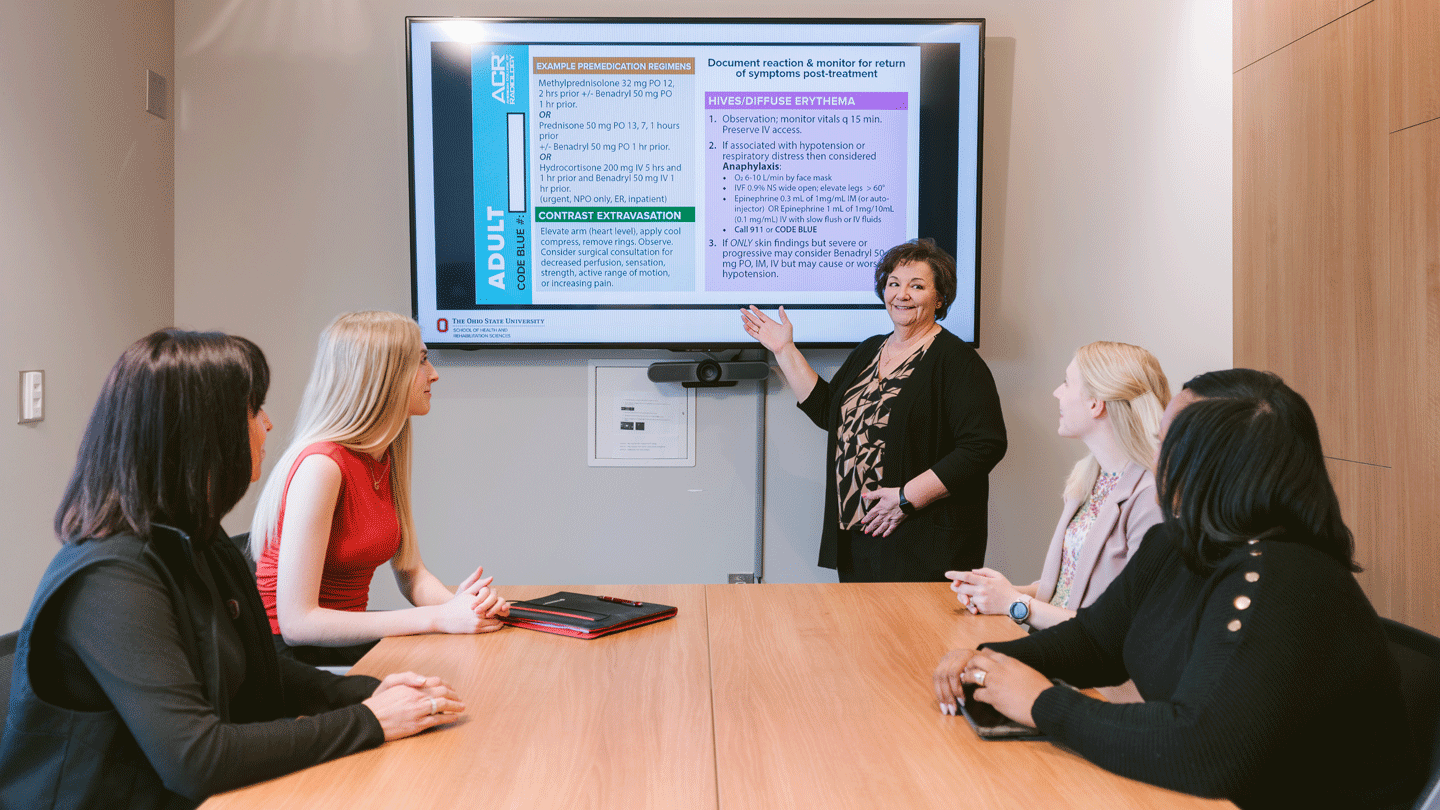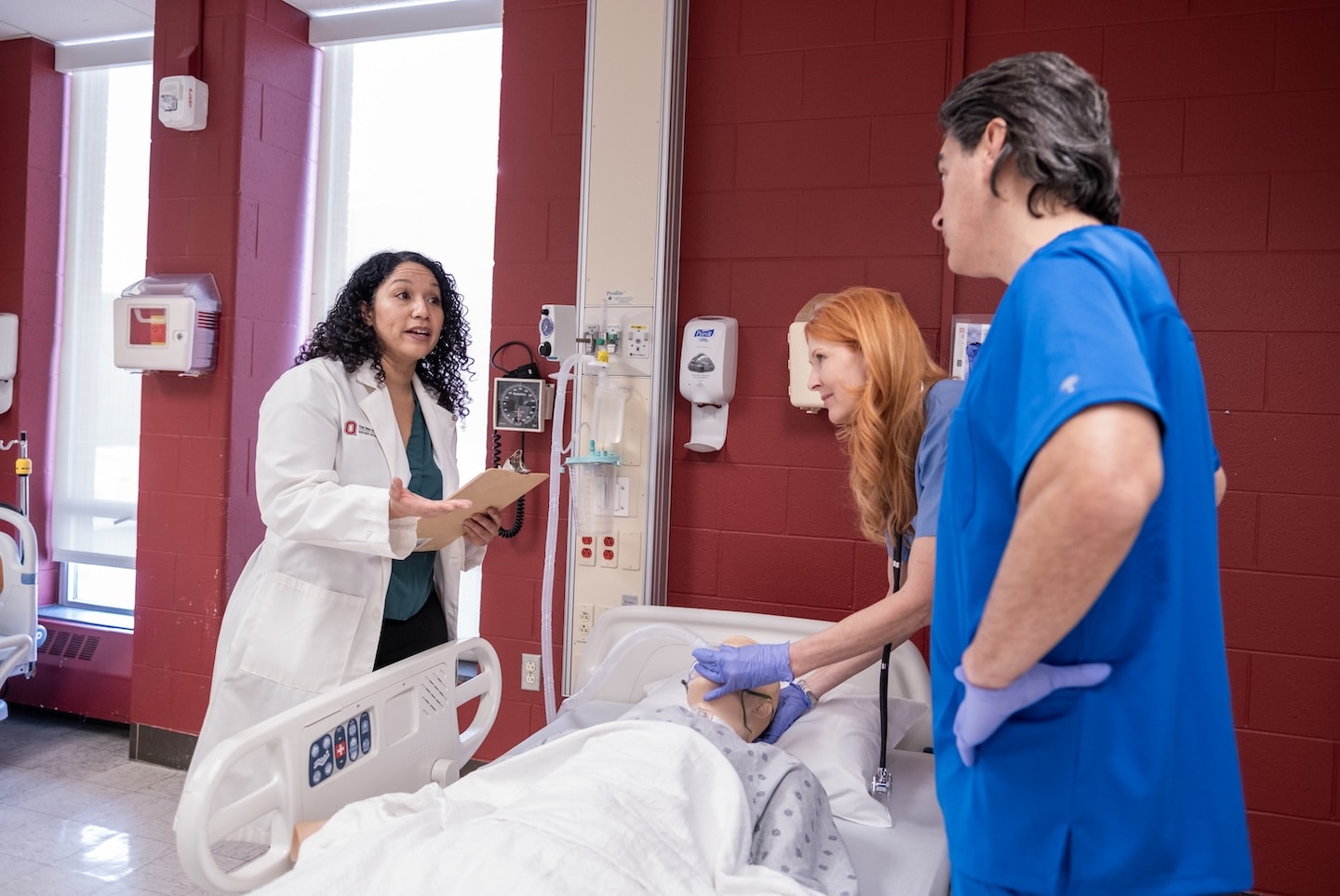Advancing to Leadership in Radiology: Tonette’s story
Learn more about AS to BS alum, Tonette, who attended Ohio State Online to earn her bachelor’s degree to pursue leadership roles within radiological tech.

After more than three decades in patient care, Tonette, a seasoned radiologic technologist, decided it was time to return to school. Not because she had to, but because she refused to let anything hold her back from a new leadership opportunity.
Now a proud graduate of the Associate of Science (AS) to Bachelor of Science (BS) in Radiologic Sciences program at The Ohio State University, Tonette reflects on how the experience helped her grow both professionally and personally, and why she encourages others in the field to do the same.
A career rooted in compassion
Tonette has a passion for patient care that has never faded. “I’m a natural caregiver and just always wanted to help people. That’s why I got into health care, and I realized I had a skillset where I could lead people to help people. Because I have that caregiving in me and I care for the team as well as the patient,” she said.
While working in Lewis Center, she recalled that a lot of her patients said they were happy that the team “brought Ohio State healthcare to them.”
“That’s my mission: I like to bring our healthcare to the community. So that’s why I get up and do it every day and I like taking care of my team because a happier team is a better experience for the patient.”
Finding the motivation to return
When a new leadership opportunity required a bachelor’s degree, Tonette started looking into the online AS to BS in Radiologic Sciences at Ohio State.
“For a long time, I thought, ‘Maybe I’ll get around to taking a class or two,’” Tonette said. As an Ohio State employee, the opportunity was right there, but it took the prospect of a leadership role to bring the decision into focus.
“They told me that if I wanted to pursue this leadership role, I would have to get my bachelor’s degree,” she explained. “And I thought, there’s no question in what’s holding me back. I felt like I was in a good position for the role, and I didn’t want that to be the reason I didn’t get it.”
Balancing work and school as an online student
For Tonette, the idea of going back to school while working full time could have been daunting, but the flexibility of an online program made it manageable.
“It was pretty easy to pick up and navigate,” she said. As both a student and an Ohio State employee, she was already familiar with CarmenCanvas, the university’s online learning platform. “It was very simple to use; from reading materials to assignments, it all made sense.” She found her rhythm quickly. “I was a really big Saturday or Sunday student,” she said. “I usually dedicated one night a week to catch up on assignments and then worked ahead on the weekend.”
Tonette credits much of her success to the support she received from her advisor. “Lisa was very helpful and very responsive when I had questions,” she shared. “My credits were old, and she helped make the process simple and guided me the entire way.”
Even in an asynchronous online setting, Tonette felt connected to her classmates. “Some of the students were taking the same courses at the same time, and you start talking, asking about each other’s jobs, where we work. Later, we interviewed some of them for positions, and they already knew who I was. That connection was really meaningful.”
Because of her extensive experience, her contributions stood out. “In human resources discussions, people were respectful and engaged with me differently. I lived what we were talking about, so they asked great questions. It was a good experience.”
Reconnecting with compassion
One class in particular left a lasting impact on Tonette, The Art and Science of Health Care.
“We read a book about a woman in extended care. No one asked her how she liked her hair or what she normally ate. They just treated her like everyone else,” she recalled. “That really stuck with me. It reminded me to bring compassion back into the daily routine.”
In her daily work, Tonette emphasized how important empathy is. “When patients come to us, they’re going through the worst day of their lives. We have to take the time to listen and be present for them.”

The value of a bachelor’s degree in health care
Earning her bachelor’s degree gave Tonette more than a credential; it gave her confidence.
“Having a degree is pretty important at an academic medical center. I didn’t realize the impact it would make until I had it. Now I feel like I’m on an equal playing field with others. My degree gave me a foundation and reminded me that I deserve to be here. I worked hard to get here.”
When reflecting on her career, Tonette has one major regret: “I wish I’d started sooner.” Even though she completed her bachelor’s while nearing the end of her career, she sees the degree as a critical part of her journey.
She also encourages technologists to be bold about their aspirations. “Apply for jobs even if you think you won’t get them. Show that you’re interested in leadership. Keep learning. Keep growing.”
Now in a leadership position as an associate director at Ambulatory Imaging Services, Tonette is paying it forward. “I encourage all the leaders below me who don’t already have their bachelor’s to go for it and then move on to a master’s. Our medical center requires these degrees for higher roles, and I don’t want a lack of education to be what holds them back.”
For those unsure about returning to school, her advice is simple: “Start with electives. Try a math class. That’s usually the hardest part for those of us who’ve been out of school. I took statistics by itself because I knew it would take everything I had.”
And for early-career technologists: “Don’t stop. If you’re already in school, keep going.” Even if you’re not ready to make a move today, this degree will set you up for success when the time is right.
What can you do with a radiology degree?
One of Tonette’s strongest beliefs is that technologists are uniquely qualified to lead because they’ve lived the work firsthand.
“Nobody knows our business like we do,” she said. “If you’ve worked on the front lines, you’re better able to make decisions that benefit both the team and the patient. When you’ve been there, you know what really makes a difference.”
She added that imaging professionals today have more career options than ever before. “There are educator positions, quality specialist roles, and more jobs that help technologists do their work better. Getting this degree puts you in a much better position to grow and keep your job fresh.”
Tonette’s story is a testament to how advanced education can open doors to new leadership roles. These titles can include imaging services manager, associate director, director, or teaching in accredited programs. Additionally, it can serve as a foundation for graduate studies in healthcare administration, or education to further broaden career opportunities and earning potential.
Earning your bachelor’s degree in radiologic sciences opens doors to advanced clinical roles for technologists, including becoming a Certified Radiology Administrator (CRA) or advancing to lead technologist, modality specialist, or clinical instructor, which often require ARRT certifications. These roles offer more responsibility, specialization, and will continue to provide higher pay throughout your career.
Leadership skills that will set you apart
When asked what qualities today’s imaging leaders need, Tonette answered without hesitation: “You need to develop a global view. You can’t be stuck in the past. Be open to new ideas, read about what others are doing, and understand what’s possible.” That mindset — rooted in experience, shaped by education — is what made Tonette’s return to school such a powerful chapter in her career. “You can do this,” she said. “Put in the work for a couple of years, and you’ll get through it. I did.”
Ohio State’s Online Bachelor’s Degree in Radiology
Whether you’re a radiographer, sonographer, radiation therapist, or MRI/CT technician, you can gain the skills to move into an administrative role and complete your bachelor’s degree in less than two years. Ohio State’s AS to BS online degree completion in Radiologic Sciences is built for working professionals like you, whether you’re ready to advance now or planning to step into leadership roles in the future. This fully online program lets you build on your associate degree and professional certification while continuing to work.
Admission Criteria:
- Associate of Science (AS) or Associate of Applied Science (AAS) degree
- Active registry with the American Registry of Radiologic Technologists (ARRT), the Nuclear Medicine Technology Certification Board (NMTCB) or the American Registry of Diagnostic Medical Sonography (ARDMS)
- Minimum GPA of 2.5
Take the next step
Explore detailed information about the AS to BS in Radiologic Sciences program—including admission requirements, curriculum, and tuition. If you have questions or need help navigating your next steps, submit your contact information to connect with an Ohio State Online Enrollment Advisor. They’ll provide one-on-one guidance, help you understand the application process and support you in taking the next step with confidence.
Recent Blog Posts
Recent Blog Posts

Empowering Lives Through Technology: Inside Ohio State’s Online Assistive and Rehabilitative Technology Certificate

Discussing the Value of Professional Development in Nursing Education

What is an Associate of Arts good for?
Get Started


